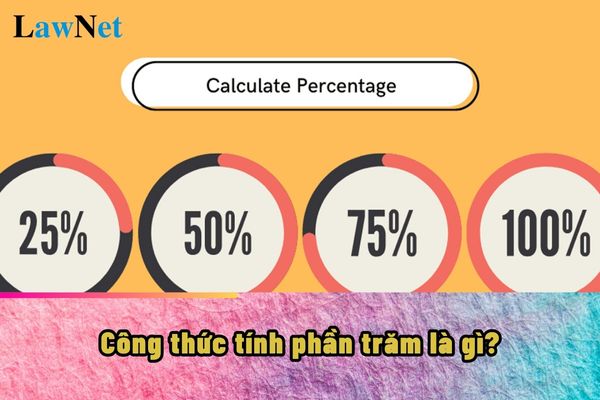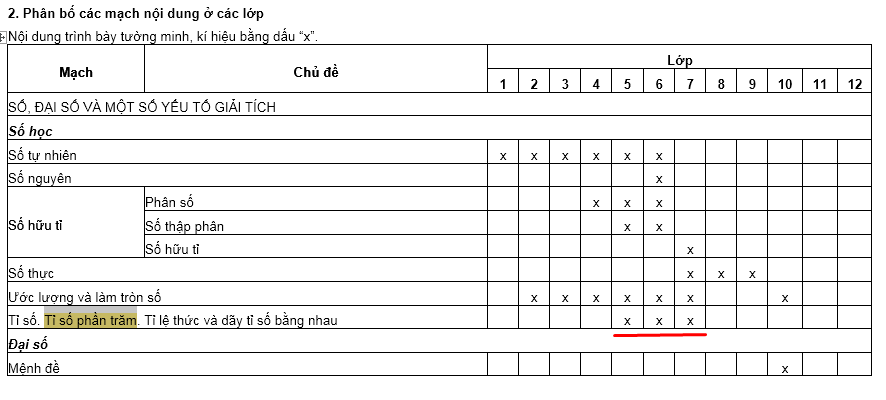What is the formula for calculating percentage? When do students in Vietnam learn the formula for calculating percentage?
What is the formula for calculating percentage?
The percentage formula is used to express a quantity as a part of a whole, typically represented by a percentage sign (%).
| General Formula: Percentage = (Part Value / Total Value) * 100% |
*Example:
Calculating score percentage: If you scored 80 out of 100 in a test, your score percentage is: (80/100) * 100% = 80%.
Calculating discount percentage: If a product originally costs 100,000 VND and is discounted to 80,000 VND, the discount percentage is: ((100,000 - 80,000) / 100,000) * 100% = 20%.
*Types of Problems Using the Percentage Formula:
Finding a percentage of a number:
Example: Find 20% of 500.
Finding a number when given a percentage of it:
Example: 15% of a number is 30. Find that number.
Calculating percentage increase or decrease:
Example: The price of a product increases from 100,000 VND to 120,000 VND. Calculate the percentage increase.
**Variation of Percentage Formulas:
Calculating percentage increase:
Percentage Increase = [(New Value - Old Value) / Old Value] * 100%
Calculating percentage decrease:
Percentage Decrease = [(Old Value - New Value) / Old Value] * 100%
*Note: Information is for reference only./.

What is the formula for calculating percentage? When do students in Vietnam learn the formula for calculating percentage? (Image from the Internet)
When do students in Vietnam learn the formula for calculating percentage?
According to Section V of the Appendix on the Mathematics Curriculum for General Education issued with Circular 32/2018/TT-BGDDT regarding the content distribution of subjects across grades, the calculation of percentages or ratio percentages is taught in Mathematics in grades 5-6 and 7 in Vietnam as follows:

Additionally, according to the curriculum for grade 5 Mathematics, students must:
- Recognize the ratio and percentage ratio of two similar quantities.
- Solve various problems related to: finding two numbers when the sum (or difference) and the ratio of these numbers are known; calculate the percentage ratio of two numbers; find the percentage value of a given number.
- Recognize map scales. Apply map scales to solve practical situations.
*Use of Handheld Calculators
Get familiar with using handheld calculators to perform addition, subtraction, multiplication, and division of natural numbers; calculate the percentage ratio of two numbers; find the percentage value of a given number.
*Decimals and Arithmetic with Decimals. Ratios and Percentage Ratios
- Recognize negative decimals, the opposite of a decimal number.
- Compare two given decimals.
- Perform addition, subtraction, multiplication, and division with decimals.
- Apply the commutative, associative, and distributive properties of multiplication concerning addition, bracket rules with decimals in calculations (written calculations, mental calculations, quick calculations reasonably).
- Estimate and round decimals.
- Calculate the ratio and percentage ratio of two quantities.
- Calculate the percentage value of a given number and find a number given its percentage value.
- Solve practical problems involving calculations with decimals, ratios, and percentage ratios (e.g., problems related to credit interest rates, chemical compositions,...).
Therefore, students in Vietnam will learn the formula for calculating percentage in grade 5.
Is grade 5 Mathematics a mandatory subject in Vietnam?
Based on Section 1 of the Mathematics Curriculum for General Education issued with Circular 32/2018/TT-BGDDT:
- Mathematics increasingly has many applications in life, and fundamental mathematical knowledge and skills have helped humans solve real-life problems in a systematic and accurate manner, contributing to societal development.
- Mathematics in general education helps form and develop key qualities, general competencies, and mathematical capabilities for students; develops core knowledge and skills and provides opportunities for students to experience and apply mathematics in practice; establishes connections between mathematical ideas, between mathematics and practice, and between mathematics and other subjects and educational activities, particularly with Science subjects, Natural Sciences, Physics, Chemistry, Biology, Technology, and Informatics to implement STEM education.
- The content of Mathematics often has a logical, abstract, and generalized nature. Therefore, to understand and learn Mathematics, the school Mathematics program needs to ensure a balance between "learning" knowledge and "applying" knowledge to solve specific problems.
- During learning and applying mathematics, students always have the opportunity to use technological means, modern teaching equipment, particularly electronic calculators and handheld calculators to support the process of demonstration, exploration, discovery of knowledge, and solving mathematical problems.
- In the general education curriculum, Mathematics is a compulsory subject from grades 1 to 12.
The mathematics education content is divided into two phases:
+ Basic Education Phase:
Mathematics helps students systematically understand the most essential mathematical concepts, principles, and rules necessary for everyone, laying the foundation for further educational levels or daily life applications.
+ Career-oriented Education Phase:
++ Mathematics helps students have a relatively comprehensive view of mathematics, understand the role and applications of mathematics in practice, and related careers to help students have a basis for career orientation, as well as have the ability to explore mathematical issues throughout their lives.
++ Besides the core educational content, in each school year, students (particularly those with natural science and technology orientation) can choose to study several specialized topics.
++ These specialized topics aim to enhance knowledge about mathematics, the ability to apply mathematical knowledge in practice, meeting the interests, needs, and career orientation of students.
+ The Mathematics curriculum in both educational phases has a linear structure combined with "spiral concentric" (concentric, expanding, and gradually advancing), revolving around and integrating three strands of knowledge:
++ Numbers, Algebra and Elements of Calculus; Geometry and Measurement; Statistics and Probability.
Thus, Mathematics is a mandatory subject from grade 1 to grade 12.

